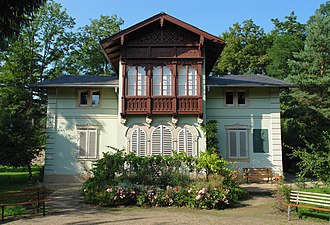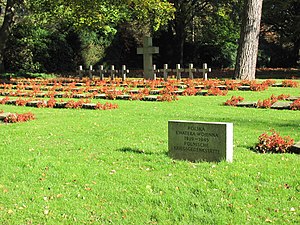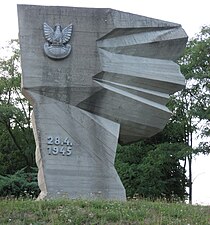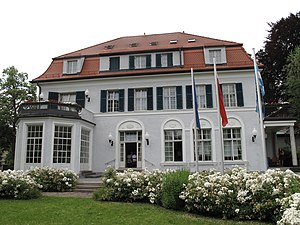Poles in Germany
 Rodło,a symbol of the Polish minority in Germany, originally used by theUnion of Poles in Germany. | |
| Total population | |
|---|---|
| 2,100,022(2020)[1] | |
| Languages | |
| Polish,German,Silesian,Kashubian | |
| Religion | |
| 75.5%Roman Catholic,13.8%non-religious,8.0%Protestantism[2] | |
| Related ethnic groups | |
| Poles,Germans,Kashubians,Poles in the United States |
Poles in Germany(German:Polen) are the second largestPolish diaspora(Polonia) in the world and the biggest inEurope.Estimates of the number ofPolesliving inGermanyvary from 2 million[3][4][5]to about 3 million people living that might be of Polish descent. Their number has quickly decreased over the years, and according to the latest census, there are approximately 866,690 Poles in Germany.[1]The main Polonia organisations in Germany are theUnion of Poles in GermanyandCongress of Polonia in Germany.Polish surnamesare relatively common in Germany, especially in theRuhr area(Ruhr Poles).
History[edit]

Since thePartitions of Polandin 1772, 1793 and 1795 and Poland's partial incorporation into Prussia, a large Polish ethnic group existed insidePrussia's borders, especially in the new provinces ofPosenandWest Prussia.Poles also settled in present-day Germany during the 18th century e.g. inDresdenandLeipzig.[6]Dresden was named Royal-Polish Residential City afterAugustus II the StrongbecameKing of Polandin 1697.[citation needed]
During the late 19th century rapid industrialisation in theRuhr regionattracted about 300,000 Poles, especially fromEast Prussia,West Prussia,Poznań,andSilesia.They comprised about 30% of the Ruhr area population by 1910.KashubiansandMasuriansalso came. Participants in this migration are called theRuhr Poles.
After 1870, the Poles were under an increasing pressure of Germanisation, and theKulturkampfattacked their Catholic Church. Most Catholic bishops were imprisoned or exiled. The teaching language which had previously been Polish in the predominantly Polish-speaking areas in Prussia was replaced by German as teaching language, even in religious education where Polish priests were replaced by German teachers. However, these Germanisation policies were not at all successful. In contrast, it led to the political awakening of many Poles and to the establishment of a wealth of Polish economic, political and cultural associations which were aimed at preserving Polish culture and Polish interests, especially in theProvince of Posenand in the Ruhr area. The policy of forced cultural Germanisation alienated large parts of the Polish-speaking population against the German authorities and produced nationalistic sentiments on both sides.

After theFirst World War,the predominantly Polish provinces had to be ceded to the newly created Polish Republic. Polish-speaking minorities remained especially in Upper Silesia and parts of East Prussia. During the 1922 to 1937 term of theGerman-Polish Accord on Upper Silesia(Geneva Agreement),[7]signed in Geneva on 15 May 1922, German nationals of Polish ethnicity in Upper Silesia had judicial status as anational minority[8]under the auspices of theLeague of Nations(likewise the Poles of German ethnicity in the PolishSilesian Voivodeship). After the rise of theNazis,all Polish activities were systematically constrained, since mid-1937 also in Upper Silesia. However, in August 1939, the leadership of the Polish community was arrested and interned in the Nazi concentration camps ofSachsenhausenandBuchenwald.On 7 September 1939, shortly after the outbreak ofWorld War II,the Nazi government of the Third Reich stripped the Polish community in Germany of its minority status. This was formally confirmed byHermann Göring's decree of 27 February 1940.
Today[edit]


Today the German government does not recognise German nationals of Polish ethnicity as a national minority. As a result, according to Polish agencies, Germany is not recognising theright of self-determinationof the Polish minority in Germany.[9]After Poland joined theEuropean Union,several organisations of Poles in Germany attempted to restore the pre-war official minority status, particularly claiming that the Nazi decree is void. While the initialmemorandumto theBundestagremained unanswered, in December 2009 the Minority Commission of theCouncil of Europeobliged the German government to formally respond to the demands within four months.[citation needed]
The position of the German government is that after the German territorial losses after World War II, the current Polish minority has no century-old roots in the remaining German territory, because Germany lost all the territories where people of German and Polish ethnicity overlapped. Since they are therefore only recent immigrants, they do not fulfill the requirements of a national minority according to theFramework Convention for the Protection of National Minoritiesand theTreaty of Good Neighbourship.Being German citizens, they still retain all civil and political rights every German citizen possesses, and therefore can voice their will in the political system.[10]
About 10,000 Polish citizens have recently moved to German localities along the Polish-German border, depopulated after the unification of Germany.[11][12]
Population distribution[edit]


Data of 2011:[13]
| State | Number of Poles | % of State population | % of Poles in Germany |
|---|---|---|---|
| North Rhine-Westphalia | 786,480
|
4.5
|
39.2
|
| Bavaria | 202,220
|
1.6
|
10.1
|
| Baden-Württemberg | 202,210
|
1.9
|
10.1
|
| Lower Saxony | 201,620
|
2.6
|
10.1
|
| Hessen | 163,200
|
2.7
|
8.1
|
| Berlin | 101,080
|
3.1
|
5.0
|
| Rhineland-Palatinate | 88,860
|
2.2
|
4.4
|
| Hamburg | 71,260
|
4.2
|
3.6
|
| Schleswig-Holstein | 55,510
|
2.0
|
2.8
|
| Brandenburg | 27,940
|
1.1
|
1.4
|
| Bremen | 26,270
|
4.0
|
1.3
|
| Saxony | 25,700
|
0.6
|
1.3
|
| Saarland | 19,870
|
2.0
|
1.0
|
| Mecklenburg-Vorpommern | 13,250
|
0.8
|
0.7
|
| Saxony-Anhalt | 10,790
|
0.5
|
0.5
|
| Thuringia | 10,140
|
0.5
|
0.5
|
| Total | 2,006,410 | 2.52 | 100.0 |
| Number of Poles in larger cities | |||||||||
| # | City | People | |||||||
|---|---|---|---|---|---|---|---|---|---|
| 1. | Berlin | 56,573 | |||||||
| 2. | Hamburg | 23,310 | |||||||
| 3. | Munich | 18,639 | |||||||
| 4. | Frankfurt | 12,174 | |||||||
| 5. | Dortmund | 10,138 | |||||||
| 6. | Cologne | 9,766 | |||||||
| 7. | Bremen | 9,455 | |||||||
| 8. | Düsseldorf | 9,316 | |||||||
| 9. | Hanover | 8,259 | |||||||
| 10. | Essen | 6,952 | |||||||
| 11. | Bonn | 6,879 | |||||||
| 12. | Nuremberg | 6,670 | |||||||
| 13. | Mannheim | 6,595 | |||||||
| 14. | Wuppertal | 5,870 | |||||||
| 15. | Duisburg | 5,423 | |||||||
| 16. | Leipzig | 5,219 | |||||||
| 17. | Wiesbaden | 4,648 | |||||||
| 18. | Gelsenkirchen | 4,517 | |||||||
| 19. | Krefeld | 4,473 | |||||||
| 20. | Offenbach | 4,112 | |||||||
Image gallery[edit]
-
Old Catholic Cemetery inDresden
-
Old inscription for the Polish Workers' Bank inBochum
-
Kraszewski-Museum in Dresden
-
Polish Soldiers' Quarter of theOhlsdorf CemeteryinHamburg
-
Klub Polskich NieudacznikówinBerlin
-
Monument to Polish soldiers inCrostwitz
-
Polish Consulate inMunich
-
Polish Embassy in Berlin
-
Polish Shop in Berlin
-
German-Polish School inLöcknitz
- Demolished palaces of Polish nobility
-
Moszyńska Palace inDresden
-
Potocki Palace inHamburg
-
Jabłonowski Palace inLeipzig
-
Raczyński Palace in Berlin
Notable individuals[edit]
See also[edit]
- Germany–Poland relations
- German minority in Poland
- Union of Poles in Germany
- List of notable Germans of Polish origin
- Association of National Minorities in Germany
References[edit]
- ^ab"Anzahl der Ausländer in Deutschland nach Herkunftsland in den Jahren 2015 und 2016".statista(in German).
- ^"Zensusdatenbank – Ergebnisse des Zensus 2011".Retrieved25 April2015.
- ^"Zensusdatenbank – Ergebnisse des Zensus 2011".Retrieved25 April2015.
- ^Wspólnota Polska."Stowarzyszenie Wspólnota Polska".Archived fromthe originalon 9 May 2015.Retrieved25 April2015.
- ^"Raport o sytuacji Polonii i Polaków za granicą 2012".Ministerstwo Spraw Zagranicznych. 2013. p. 177.Retrieved27 November2013.
- ^"Muzeum Emigracji w Gdyni".Retrieved26 November2014.
- ^Cf."Deutsch-polnisches Abkommen über Oberschlesien “(Oberschlesien-Abkommen, OSA) of 15 May 1922, in:Reichsgesetzblatt,1922, part II, pp. 238ff.
- ^Rak, Krzysztof (2010)."Sytuacja polskiej mniejszości narodowej w Niemczech"(PDF).p. 36. Archived fromthe original(PDF)on 29 June 2014.Retrieved27 November2013.
- ^Rak, Krzysztof (2010)."Sytuacja polskiej mniejszości narodowej w Niemczech"(PDF).pp. 34–38. Archived fromthe original(PDF)on 29 June 2014.Retrieved27 November2013.
- ^Answer to Small inquiry to the German Government by MP Ulla Jelpke and thePDS,9 September 2000, German Federal Government
- ^Tysiące Polaków przenosi się na niemiecką stronę Odry
- ^Neues Leben für die Uckermark
- ^"Zensusdatenbank – Ergebnisse des Zensus 2011".Retrieved25 April2015.
Further reading[edit]
- Cyganski, Miroslaw. "Nazi Persecutions of Polish National Minorities in the Rhineland-Westphalia Provinces in the Years 1933–1945,"Polish Western Affairs(1976) 17#12 pp 115–138
- Fink, Carole. "Stresemann's Minority Policies, 1924–29,"Journal of Contemporary History(1979) 14#3 pp. 403–422in JSTOR
- Kulczycki, John J.School Strikes in Prussian Poland 1901–1907: The Struggle over Bilingual Education(1981)
- Kulczycki, John J.The Polish Coal Miners' Union and the German Labor Movement in the Ruhr, 1902–1934: National and Social Solidarity(1997)
- Kulczycki, John J.The Foreign Worker and the German Labor Movement: Xenophobia and Solidarity in the Coal Fields of the Ruhr, 1871–1914(1994)
- Riekhoff, Harald von.German-Polish Relations, 1918–1933(1971).
- Sobczak, Janusz. "The Centenary of Polish Emigration To Rhineland-Westphalia,"Polish Western Affairs(1970) 11#1 pp 193–198.
- Wynot, Edward D. "The Poles in Germany, 1919-139,"East European Quarterly,1996 30#2 pp 171+onlinebroad overview
















